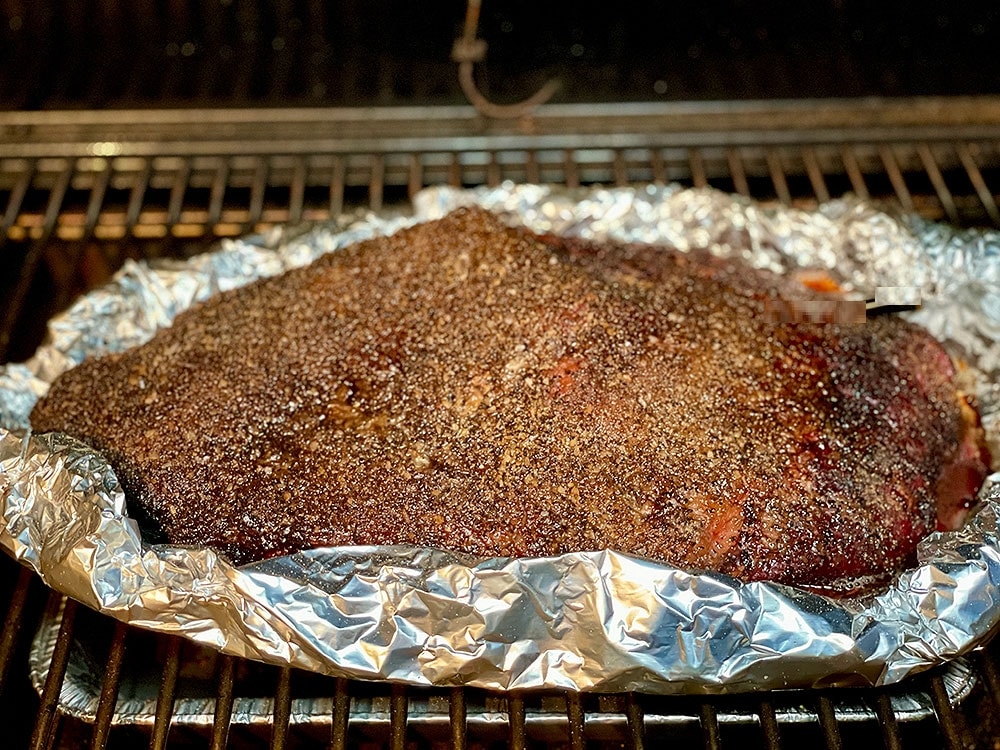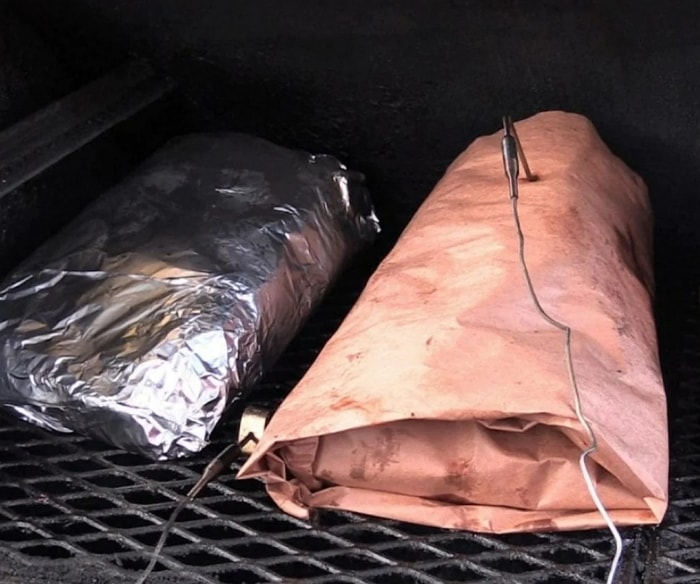If you’re new to smoking brisket and have all those burning questions:
- Do you have to wrap a brisket?
- When should I wrap my brisket?
- Do you add liquid when you wrap a brisket?
- How to wrap a brisket?
- What temp to wrap brisket?
- How long to cook brisket after wrapping?
Don’t worry—I’ve got your back! Continue reading and get all your answers for the perfect smoked brisket.

When it comes to wrapping brisket, the internet is full of different voices in the classic wrap vs. unwrap debate.
Some swear by wrapping, saying it speeds up the cook and keeps the brisket juicy.
On the other side, the purists argue that unwrapping is the way to go, preserving that perfectly crunchy bark and letting the brisket develop a deep, smoky flavor.
Each camp has its die-hard supporters, and honestly, the best approach depends on what you’re aiming for in texture, flavor, and cooking style. I love hearing different takes because it just shows how personal BBQ really is!
Table of contents
What is Wrapping Brisket?
Wrapping brisket is a technique that a lot of pitmasters use to help manage the cooking process, particularly when the brisket hits “the stall.” The stall is this weird phase where the internal temperature of the brisket just kind of plateaus—usually around 160-170°F—and stays there for what feels like forever.
When this happens, some people choose to wrap the brisket in aluminum foil or butcher paper. This helps the brisket cook faster and evenly by trapping moisture inside, preventing it from drying out.
Do You Have to Wrap a Brisket?
Is it always necessary to wrap your brisket at 165°F? Not really! Wrapping, or the “Texas Crutch,” helps push your brisket through the stall and can speed up the process by retaining moisture. This technique can help you reach your target internal temperature faster, but it’s definitely not mandatory.
Wrapping is great for locking in juiciness, but it also softens the bark, so it’s a bit of a trade-off depending on what texture you’re after. Recently, we decided to take a shot at the foil-boat method. This method claims to leave the top of the brisket exposed while wrapping the bottom, which helps maintain a crispy bark while still protecting the meat from drying out. If you’re curious about trying something new, the foil-boat might be a fun experiment!
Remember to use a reliable wireless meat thermometer to keep track of your temps—it makes all the difference in ensuring your brisket is cooked to perfection!

Smart Bluetooth and WiFi Meat Thermometer

What Temp to Wrap Brisket?
Before you wrap a brisket it needs to be smoked for several hours. This phase of smoking allows the brisket to develop a good crust on the outside and absorb smoky flavors from wood or charcoal. Expert pitmasters refer to this crust as “bark.”
Once the bark has formed and the brisket has reached a certain level of doneness, the liquid evaporating from the meat cools the brisket and the cooking slows down significantly. This is what pitmasters refer to as “the stall”. You want to wrap your brisket before the stall.
With the help of a meat thermometer for brisket, you can monitor the temperature of the brisket as it cooks and when it reaches 160°F-170°F, you can wrap the brisket.

Wrapping the brisket at this stage also helps keep it moist and tender by trapping the juices and preventing it from drying out. If you wrap a brisket too early, you may end up with a softer, less textured bark. If you wrap the brisket late, it may take a lot longer to cook.
Why Do You Wrap Brisket?
1. Cooks Faster
The main reason to wrap a brisket is to cut down on cooking time.
When you wrap brisket, you create an environment where the meat is essentially steaming in its own juices. This helps to accelerate cooking by increasing the temperature inside the wrapping material, surrounding the meat with heat.
The increased temperature can help break down collagen and other connective tissues, making it more tender.
2. Juicier Meat
Wrapping the brisket with foil or butcher paper helps trap moisture inside and prevents the meat from drying out, resulting in juicier meat.
The moisture inside the wrapped brisket is trapped steam from the meat’s natural juices which also helps breaks down tough connective tissues, making it more tender with a stronger flavor.

3. Control the Bark
People love bark on a brisket, but sometimes you can have too much bark. That usually happens if you cook with the heat too high or if there’s not enough moisture in the smoker. Wrapping a brisket can help control that.
Wrapping the meat in foil or butcher paper creates an insulator, trapping moisture inside the brisket. In that process, the bark will soften — which is not ideal — and the meat will cook faster.
If you want your brisket to cook fast and have a good bark, when the internal temperature reaches 195°F, unwrap the meat and turn up the heat of your smoker to 225°F and cook the brisket until the bark looks good to you.
Wrap Brisket in Butcher Paper or Aluminum Foil?
Usually, pitmasters will wrap brisket in either butcher paper or aluminum foil. While both materials are great for wrapping brisket, there are some differences in how they affect the flavor and texture of your brisket.
The choice of wrapping material ultimately comes down to personal preference and what goals you want to achieve.

Butcher Paper
Butcher paper is a type of food-grade paper that is permeable to moisture and air, which allows it to trap in steam while still allowing smoke and heat to penetrate the meat. This allows the meat to retain its moisture and develop a flavorful bark. Butcher paper also allows for better airflow around the meat.
Aluminum Foil
Aluminum foil, on the other hand, creates an airtight seal around the meat that traps moisture and flavor. This can be beneficial for briskets that are prone to dry out, as the foil keeps the meat moist. Foil can also help speed up the cooking time.
Butcher Paper vs Aluminum Foil
In terms of texture and flavor, brisket wrapped in butcher paper tends to have slightly crisper bark and a more pronounced smoky flavor, while foil-wrapped brisket has a softer texture and a mild smoky flavor.
Some pitmasters may use a combination of both materials, starting with butcher paper and switching to foil later in the cooking process to achieve their desired results.
How Long Do You Cook Brisket After Wrapping?
The factors that determine your cooking time after wrapping are the size and thickness of your brisket, cooking temperature, and your desired doneness.
The easiest way to ensure the brisket is cooked after wrapping is to check its internal temperature. Briskets are typically perfectly cooked to the temperature of 195°F-205°F (90°C-96°C).
Smart wireless meat thermometers, like the Typhur Sync, are commonly used to monitor the internal temperature of brisket in real time, aiming for the target temperature while also considering the desired level of tenderness and juiciness. Typhur Sync wireless meat thermometer seamlessly combines two 6-sensor probes and a Base Station with a 2.4-inch display, Bluetooth 5.4, and built-in Wi-Fi for accurate and reliable wireless temperature monitoring, with or without a mobile app.

If you don’t have a smoker, you can try this perfect sous vide smoked brisket recipe.
Wrapped vs Unwrapped
Ultimately, whether or not to wrap your brisket during smoking is a matter of personal preference.
Some pitmasters swear by wrapping, while others prefer to cook their brisket unwrapped the entire time. Experiment to know what works best for you!




